Input interpretation

nitrogen dioxide
Chemical names and formulas
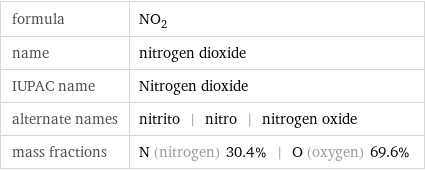
formula | NO_2 name | nitrogen dioxide IUPAC name | Nitrogen dioxide alternate names | nitrito | nitro | nitrogen oxide mass fractions | N (nitrogen) 30.4% | O (oxygen) 69.6%
Lewis structure

Draw the Lewis structure of nitrogen dioxide. Start by drawing the overall structure of the molecule, ignoring potential double and triple bonds: Count the total valence electrons of the nitrogen (n_N, val = 5) and oxygen (n_O, val = 6) atoms: n_N, val + 2 n_O, val = 17 Calculate the number of electrons needed to completely fill the valence shells for nitrogen (n_N, full = 8) and oxygen (n_O, full = 8): n_N, full + 2 n_O, full = 24 Subtracting these two numbers shows that 24 - 17 = 7 bonding electrons are expected (in such cases with an odd number, round down to 6 bonding electrons). Each bond has two electrons, so in addition to the 2 bonds already present in the diagram add 1 bond. To minimize formal charge oxygen wants 2 bonds and nitrogen wants 3 bonds. Identify the atoms that want additional bonds and the number of electrons remaining on each atom: Fill in the 1 bond by pairing electrons between adjacent highlighted atoms. Note that double bonding nitrogen to the other highlighted oxygen atom would result in an equivalent molecule: Answer: | |
3D structure

3D structure
Basic properties
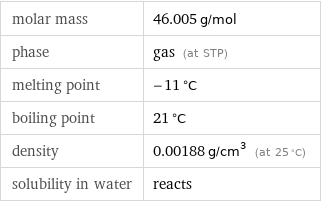
molar mass | 46.005 g/mol phase | gas (at STP) melting point | -11 °C boiling point | 21 °C density | 0.00188 g/cm^3 (at 25 °C) solubility in water | reacts
Units

Gas properties (at STP)
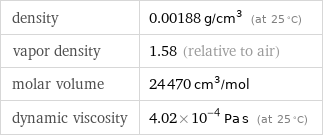
density | 0.00188 g/cm^3 (at 25 °C) vapor density | 1.58 (relative to air) molar volume | 24470 cm^3/mol dynamic viscosity | 4.02×10^-4 Pa s (at 25 °C)
Units

Thermodynamic properties
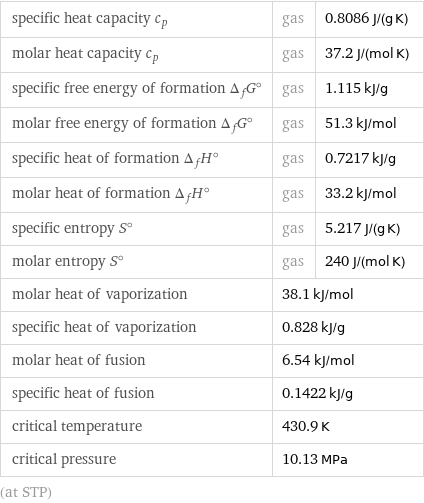
specific heat capacity c_p | gas | 0.8086 J/(g K) molar heat capacity c_p | gas | 37.2 J/(mol K) specific free energy of formation Δ_fG° | gas | 1.115 kJ/g molar free energy of formation Δ_fG° | gas | 51.3 kJ/mol specific heat of formation Δ_fH° | gas | 0.7217 kJ/g molar heat of formation Δ_fH° | gas | 33.2 kJ/mol specific entropy S° | gas | 5.217 J/(g K) molar entropy S° | gas | 240 J/(mol K) molar heat of vaporization | 38.1 kJ/mol | specific heat of vaporization | 0.828 kJ/g | molar heat of fusion | 6.54 kJ/mol | specific heat of fusion | 0.1422 kJ/g | critical temperature | 430.9 K | critical pressure | 10.13 MPa | (at STP)
Chemical identifiers
![CAS number | 10102-44-0 PubChem CID number | 3032552 PubChem SID number | 24857797 SMILES identifier | N(=O)[O] InChI identifier | InChI=1/NO2/c2-1-3 RTECS number | QW9800000 MDL number | MFCD00085341](../image_source/d542113fd914d779c26fb172508b544d.png)
CAS number | 10102-44-0 PubChem CID number | 3032552 PubChem SID number | 24857797 SMILES identifier | N(=O)[O] InChI identifier | InChI=1/NO2/c2-1-3 RTECS number | QW9800000 MDL number | MFCD00085341
NFPA label

NFPA label
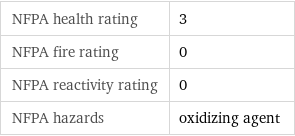
NFPA health rating | 3 NFPA fire rating | 0 NFPA reactivity rating | 0 NFPA hazards | oxidizing agent
Toxicity properties

short-term exposure limit | 9 mg/m^3

long-term exposure limit | 5 mg/m^3 (over 8 hours) RTECS classes | mutagen | reproductive effector | human data